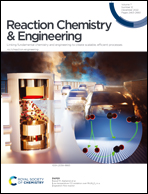Catalytic reduction of in-flow aqueous Cr(vi) using a slurry of activated carbon fiber-supported Ni nanoparticles in a coiled flow inverter
Abstract
This study presents a coiled flow inverter (CFI) for the first time as an alternative technology to the conventional packed bed reactors for carrying out the in-flow aqueous phase catalytic reduction of hexavalent chromium (Cr(VI)). Cr(VI) is reduced to its less-toxic trivalent state, namely, Cr(III), utilizing an environmentally benign reducing agent – formic acid. An aqueous slurry of micron-sized activated carbon fiber (ACF)-supported Ni metal nanoparticles is used for the first time to successfully catalyse the reduction reaction in the serially connected CFI units. The data show the Cr(VI) to Cr(III) conversion of ∼98% for the 4 mM-Cr(VI) solution under the optimized conditions, 200 cc min−1 feed flow rate, 5 mg mL−1 Ni/ACF catalyst dose, and 0.8 M concentration of formic acid, in four CFI units connected in series. A pseudo first-order kinetic rate constant of 1.94 min−1 measured for the reduction reaction is found to be in the same order of magnitude as that reported in the literature for the batch mode. The data also confirm the competitive efficiency of the proposed CFI-mediated heterogeneous reaction compared to that of the presently used packed bed reactors for the catalytic reduction of aqueous Cr(VI), attributable to the intensified mixing characteristics of the CFI.



 Please wait while we load your content...
Please wait while we load your content...